Essential Vermeer Newsletter no. 42
Jul 22, 2020
Jul 22, 2020
Click here to access this newsletter as a SIMPLE TEXT document.
IN BRIEF :
1. Major Vermeer-related exhibiton to be held in Dresden, 2021
5. Latest results of the technical study of Vermeer's Girl with a Pearl Earring
6. Six new technical investigations of Vermeer's Girl with a Pearl Earring
8. Astronomer attempts to refine dating of Vermeer’s View of Delft, Donald Olson
9. In-depth illustrated study of Vermeer's Studio (Essential Vermeer addition)
10. 60 seventeenth-century paintings of atists at work (Essential Vermeer addition)
Please remember the Essential Vermeer when you change your email address!
1.Vermeer: Johannes Vermeer's Dresden Girl Reading a Letter at the Open Window and Dutch Genre Painting from the 17th Century
March 19–June 27, 2021
Gemäldegalerie Alte Meister, Dresden
https://gemaeldegalerie.skd.museum/ausstellungen/vermeer-johannes-vermeers-dresdner-briefleserin-am-offenen-fenster-und-die-hollaendische-genremalerei-des-17-jahrhunderts/

from the Gemäldegalerie website:
Since 2017, Vermeer's early Girl Reading a Letter at the Open Window has been restored after extensive investigations in Dresden. The demanding and time-consuming restoration will be completed in about half a year. It is already clear how serious the appearance of the painting is changing. The spectacular restoration will result in a changed view of the painting and will lead to an art historical reorganization of the work.
On the occasion, the Gemäldegalerie is planning the exhibition Vermeer, which is to be shown in the special exhibition rooms of the Semper building on the Zwinger in only one exhibition station.
At the heart of the exhibition are the Girl Reading a Letter at the Open Window and another 9 paintings by Vermeer that are closely related to the picture. Moreover, 40–50 works of Dutch genre painting from the second half of the 17th century, including major works by Pieter de Hooch, Frans van Mieris, Gerard Ter Borch, Gabriel Metsu, Gerard Dou, Emanuel de Witte and Jan Steen, also present Vermeer's artistic environment with whom he was in close contact. Selected examples from other art forms such as sculptures, graphic prints, porcelain and historical furniture will enrich the exhibition in a meaningful relationship to individual paintings. As a result of the research project, the painting technique and restoration of the Girl Reading a Letter at the Open Window will be devoted to a separate exhibition segment to illustrate the complex.
An extensive accompanying program, which includes film documentation and a digitorial, as well as special tours, a series of lectures and a reading series, serves to convey the ambitious exhibition project. A catalog and a children's guide will be published for the special exhibition.
Below are the Vermeer paintings that will be part of the exhibition. One work has yet to be announced.
Diana and her Companions
The Procuress
Girl Reading a Letter by an Open Window
The Girl with a Wineglass
Woman in Blue Reading a Letter
Woman Holding a Balance
Woman with a Pearl Necklace
The Geographer
Lady Standing at the Virginal

Masterpieces from the National Gallery
June 18–October 18, 2020
National Museum of Western Art, Tokyo
https://www.nmwa.go.jp/jp/exhibitions/pdf/2020london_gallery_new.pdf
Masterpieces from the National Gallery, London is a largest exhibition ever drawn from the collection of the National Gallery, London. It will include a total of 61 never-before-shown works. Viewers can look forward to world-renowned masterpieces such as Vermeer's A Lady Seated at a Virginal and Vincent van Gogh's, Sunflowers (1888). Originally scheduled to open on 3rd March, the exhibition will begin its four-month stint at the National Museum of Western Art, Tokyo on 18th June, followed by two other venues.
second venue:
National Museum of Art, Osaka
November 3, 2020–January 31, 2021
third venue:
Botticelli to Van Gogh: Masterpieces from the National Gallery
March 5–June 14 , 2021
National Gallery of Australia, Canberra
https://nga.gov.au/masterpieces/
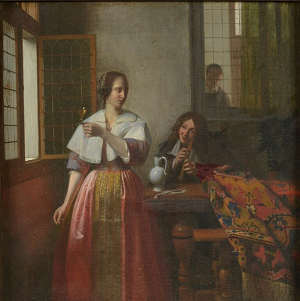
About Johannes Vermeer: A Case Study
June 17–July 17, 2020
Keizerskapel, Keizerstraat 21-23, B-2000 Antwerp, Belgium
The CODART website has just released the announcement of an upcoming presentation called "About Johannes Vermeer: A Case Study." Dr. Jean-Pierre Désiré De Bruyn will present a previously unknown Dutch painting entitled A Young Woman with Wine Glass and Musician Playing a Tenor Recorder (oil on canvas, 47 x 47 cm.) at the Keizerskapel, in Antwerp from June 17 to July 17, 2020.
While stopping short of attributing the painting directly to Vermeer, De Bruyn draws a number of analogies to his authentic works claiming that among the painting's Vermeer ingredients are the background chair with lion-head finials, the gray-wall, the carpet (see that of Vermeer's The Music Lesson), the white faience jug with a silver cap and lady's dress (almost identical to that of Vermeer's The Glass of Wine). He further writes that although "further comparisons can be made with works by Pieter de Hooch, Gabriel Metsu... it seems justifiable that our painting refers to an unknown composition by Johannes Vermeer, dating from the beginning of the 1660's."
drawn from:
About Johannes Vermeer: A Case Study: Keizerskapel, Antwerp CODART
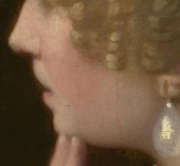
Johannes Vermeer’s 'Mistress and Maid': New Discoveries Cast Light on Changes to the Composition and the Discoloration of Some Paint Passages
by Dorothy Mahon, Silvia A. Centeno, Margaret Iacono, Federico Carό, Heike Stege & Andrea Obermeier
https://heritagesciencejournal.springeropen.com/articles/10.1186/s40494-020-00375-2
Since the nineteenth century, with the growth in the number of studies focusing on Vermeer’s paintings, critics and scholars have struggled to understand the visual peculiarities presented by Mistress and Maid. Recent advances in imaging techniques coupled with the improvement in the sensitivity of microanalytical methods have allowed a team of specialists to address the long-standing questions as well as to resolve some persistent misunderstandings. Among the discovers made while examining this unusually large-scale composition are that a tapestry or painting with multiple figures originally filled up background and that previous speculation that the painting was left in an unfinished state can be definitively put to rest. Discoveries pertaining to a few of the work's original color, which have degraded after the painting left the artist's easel, are also reported.
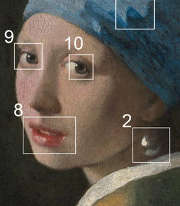
The Girl in the Spotlight: Vermeer at Work, his Materials and Techniques in Girl with a Pearl Earring
Abbie Vandivere, Jørgen Wadum & Emilien Leonhardt
Heritage Science volume 8, Article number: 20 (2020)
https://heritagesciencejournal.springeropen.com/articles/10.1186/s40494-020-0359-6
The 2018 technical examination project The Girl in the Spotlight aimed to characterize the materials and techniques that Johannes Vermeer used to paint Girl with a Pearl Earring. Five research questions guided the micro- and macro-scale analyses: What can we find out about layers beneath the surface? What steps did Vermeer take to create the painting? Which materials did Vermeer use and where did they come from? Which techniques did Vermeer use to create subtle optical effects? What did the painting look like originally, and how has it changed? This paper concludes the special issue of Heritage Science by summarizing the results and putting them in an art-historical and materials history context.
The Girl in the Spotlight: A technical re-examination of Vermeer's Girl with a Pearl Earring
edited by Abbie Vandivere (Mauritshuis, The Hague)
https://www.springeropen.com/collections/gits
In 2018, Johannes Vermeer's Girl with a Pearl Earring underwent a technical examination within the research project The Girl in the Spotlight. The painting was examined in front of the museum public with state-of-the-art non-invasive imaging techniques. Samples taken during the 1990s were re-analysed. The goal was to document the current condition of the painting, and to find out more about the materials, techniques that Vermeer used to create this masterpiece. This special collection of articles in Heritage Science is devoted to the results of the technical examination.
The research project The Girl in the Spotlight is a Mauritshuis initiative and involves a team of internationally recognized specialists associated with the Netherlands Institute for Conservation+Art+Science+ (NICAS)+, and scientists from the University of Antwerp, Belgium, and the National Gallery of Art, Washington DC, USA.
It has thus far yielded ten technical reports, all of which are accessible at https://www.springeropen.com/collections/gits.
Did Tim Paint a Vermeer?
by David G. Stork, Christopher W. Tyler, and Sara J. Schechner
![]() http://www.essentialvermeer.com/misc/StorkTylerSchechner21.pdf
http://www.essentialvermeer.com/misc/StorkTylerSchechner21.pdf
Tim’s Vermeer is a 2013 documentary feature-film following engineer and self-described non-artist Tim Jenison’s extensive efforts to “paint a Vermeer,” (The Music Lesson) by means of a novel optical telescope and mirror-comparator procedure. In this article David Stork, Christopher Tyler and Sara Schechner examine Jenison’s proposed telescope optics in historical perspective, the difficulty and efficacy of the mirror comparator procedure and the particular visual evidence adduced in support of the comparator hypothesis. The authors contend some of Jenison key claims, including that the luminescence gradient along the rear wall of Vermeer's painting was impossible to achieve without the use of an optical instrument, as well as the fact that a slight bowing of a few straight lines of the virginals can be explained without the use of a concave mirror, which is part of Jenison's device. The study emphasizes not only that Jenison's apparatus would have been one of the most complicated optical systems of its time, but that it has thus far been proven particularly difficult to operate in a practical studio setting.
(Submitted for peer-reviewed publication)
David G. Stork — scientist and author, who has made contributions to machine learning, pattern recognition, computer vision, artificial intelligence, computational optics, image analysis of fine art, and related fields.
Christopher W. Tyler — Head, Smith-Kettlewell Brain Imaging Center, Smith-Kettlewell Eye Research Institute
Sara J. Schechner — David P. Wheatland Curator Collection of Historical Scientific Instruments, Harvard University
Dating Vermeer’s View of Delft
in Sky & Telescope (25–20)
Donald Olson, Regents Professor Emeritus
https://skyandtelescope.org/magazine_categories/sky-and-telescope-magazine/
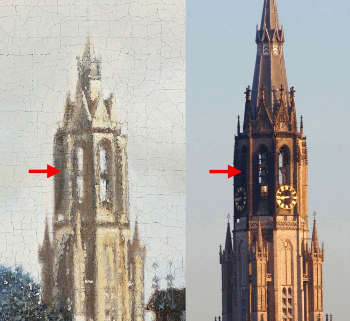
Known as the "celestial sleuth" for his work in so-called "forensic astronomy,," Donald Olson, an astronomer at Texas State University, and a few colleagues, were able to determine the precise time of day that Life magazine photographer Alfred Eisenstaedt took iconic photograph: a sailor and a woman in a white nurse's uniform kissing in the young lady. More recently Olson turned his attention to Vermeer's View of Delft. After lengthy investigation which entailed making precise measurements of the painting's architectural features, traveling to Delft to make on-site measurements, including topographical surveys and taking photographs roughly in line with what would have been Vermeer's viewpoint, he claims that he ia able to give a more accurate date of the painting. He states "If Vermeer intended to portray a morning scene consistent with the time shown by the clock in the painting, then the combined evidence—the hour hand of the Schiedam Gate clock, the empty bell tower, and the Sun’s position in the sky—indicates that the painting dates from 1659 or an earlier year and matches the view that the artist could have observed from his window at the inn at 8:00 a.m. on a date near September." Although Olson grants the painting could have taken weeks,mon ths or even years to paint, he maintains that "the remarkably accurate depiction of the distinctive and fleeting pattern of light and shadows on the Nieuwe Kerk suggests that at least this detail was inspired by direct observation of the sunlit tower rising above the wall and roofs of Delft."
review:
https://phys.org/news/2020-07-celestial-sleuth-vermeer-masterpiece-view.html
Vermeer's Studio: Essential Vermeer
Jonthan Janson
http://www.essentialvermeer.com/technique/vermeer's-studio.html
Although the artist's studio had been occasionally portrayed during the Renaissance—the place was not actually called a studio until the nineteenth century—it became a very popular motif in the seventeenth-century Netherlands. Particularly numerous were pictures of the workplaces of destitute artists. But not all studios were dilapidated: Vermeer's was certainly not. While we do have one painting by Vermeer of an artist in his studio , it represents an ideal of the artist's studio rather than the real conditions in which the artist went about the day-to-day chore of creating his masterpieces. This study provides abundant information on what we know of seventeenth-century studio and how Vermeer's studio differed from those of his colleagues. Every aspect of Vermeer's studio, which include the location, dimensions, layout, windows, flooring, studio clothing and environmental conditions, is examined in detail and corroborated by a wealth of diagrams and high-resolution images. Also discussed are Vermeer's studio equipment and favorite props.
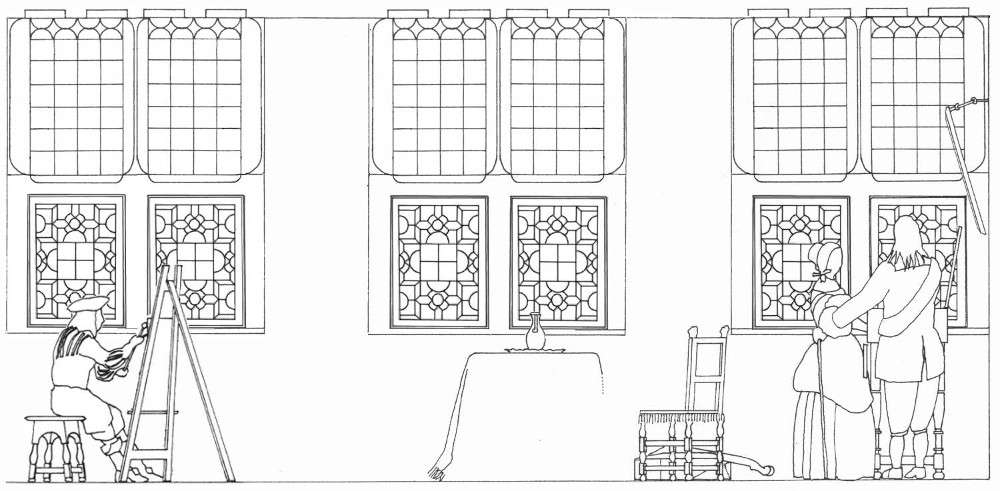 Vermeer's studio, drawn from three drawings of Philip Steadman, Vermeer's Camera: Uncovering the Truth behind the Masterpieces (2002) courtesy of Philip Steadman
Vermeer's studio, drawn from three drawings of Philip Steadman, Vermeer's Camera: Uncovering the Truth behind the Masterpieces (2002) courtesy of Philip SteadmanThis brand new "Essential Vermeer" web addition features a collection of 66 paintings of seventeenth-century Dutch painters at work displayed with a user-friendly carousel interface.
http://www.essentialvermeer.com/technique/painters-studios-in-the-netherlands.html
"Cocktails with a Curator: Vermeer's 'Officer and Laughing Girl'"
by Frick curator Aimee Ng
https://www.youtube.com/watch?v=zol1VWHPKdU&list=PLNVeJpU2DHHR_0y_Zvgn3MgZQQFcFx2eI&index=1
Have you heard about the weekly Cocktails with a Curator video premieres yet? Friday at 5 p.m. NYC time....a curator of the Frick Collection speaks in a fresh way about a work from the renowned New York collection collection, often with reference to the moment we're in... and there is a cocktail (and mocktail) accompaniment as well.
In this week’s episode of Cocktails with a Curator, get up close to one of the Frick’s three beloved Vermeer paintings, Officer and Laughing Girl, with Curator Aimee Ng. While enjoying your Kopstootje—a shot of jenever (a traditional Dutch liquor) paired with a pint of beer—join Aimee in examining the artist’s masterful skill at portraying light and exploring the complex histories behind a seemingly simple hat.
(See the playlist of all published Cocktails with a Curator on the icon with "1/15" of the video below)
If you discover a  or anything else that isn't working as it should be, I'd love to hear it! Please write me at: jonathanjanson@essentialvermeer.com
or anything else that isn't working as it should be, I'd love to hear it! Please write me at: jonathanjanson@essentialvermeer.com